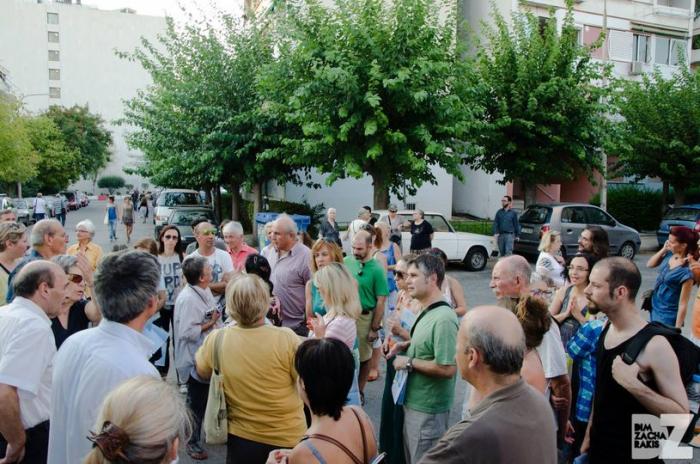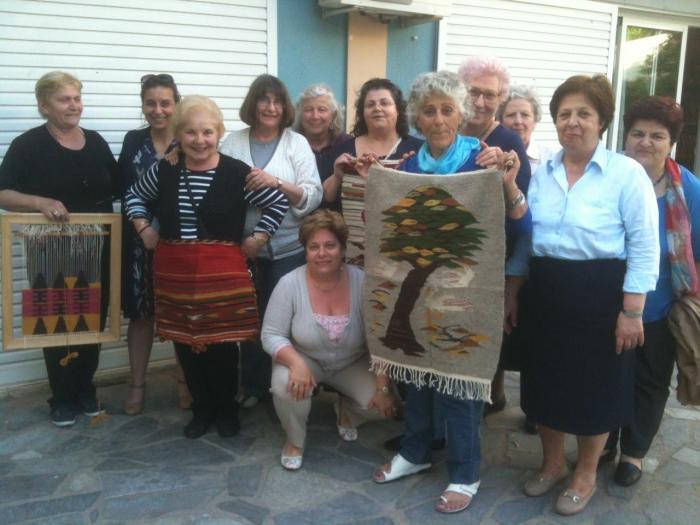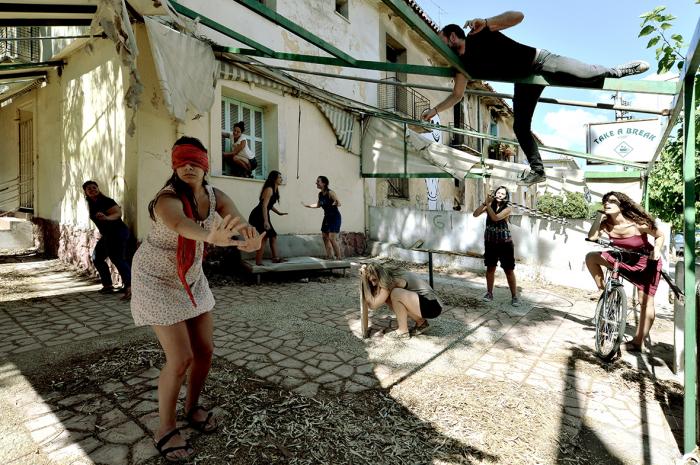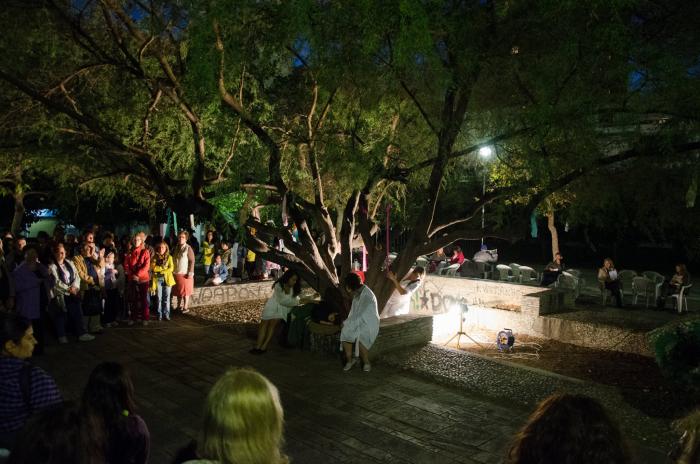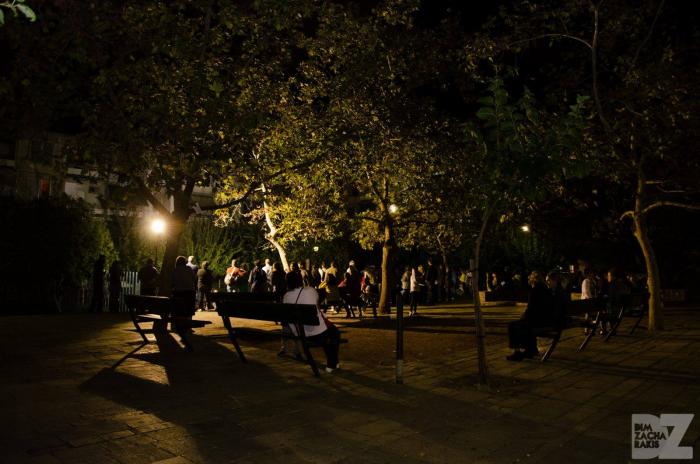I. SUMMARY INFORMATION
Project
268730
Status
Submitted
Award category
Reinvented places to meet and share
You want to submit
NEW EUROPEAN BAUHAUS AWARDS : existing completed examples
Project title
Dourgouti Island Hotel
Full project title
UrbanDig Project: “Dourgouti Island Hotel”
Description
“Dourgouti Island Hotel” combines performing arts with community mapping practices with a site-specific performance born of rich material that derives from a palette of collective actions.
Where was your project implemented in the EU?
Greece
Attika
Dourgouti – Neos Kosmos, Athens, Greece
Athens
11745
When was your project implemented?
Has your project benefited from EU programmes or funds?
Yes
Which programme(s) or fund(s)? Provide the name of the programme(s)/fund(s), the strand/action line as relevant and the year.
II. DESCRIPTION OF THE PROJECT
Please provide a summary of your project
Dourgouti Island Hotel was an UrbanDig Project that “dug” into the urban space. “UrbanDig Projects” have as a main aim the design and implementation of community, educational and artistic projects. With public space being the main field of action, we use techniques of dialogue, participatory research, collaborative activities and art, hoping to contribute to a bottom-up alternative reading of the urban space and its cultural capital.The starting point as well as the festive finale of each project is a site-specific performance born by the rich material that derives from a palette of collective actions.
Into that context, Dourgouti Island Hotel collected the neighborhood’s “secrets”, attempting to “dig” under the visible urban mosaic towards its invisible layers and beyond the “formal” visible narratives. Keeping the site-specific performance as a central sparkle and a final goal, many collective actions took place, organized with and by the neighborhood, cultivating a sense of community and activating horizontal cross-sectoral networks. More specifically, 6 methodological axes formed 6 working groups: oral history; historical mapping; sensory mapping; skill/interests mapping; community aspirations/challenges mapping; mapping of cultural and sports activity. These working groups employed parallel process tools, organising festivals, walking tours, workshops, creating a neighbourhood website and a walking tour app, making links to institutions, the academia, cultural foundations, international networks and the EU Culture program. The data derived from the community and was reattributed back to it through processes (festivals, performance, archive, sustainability of working groups, renewable website) that encouraged an opening beyond its limits, inviting visitors to become familiar and part of it.
Please give information about the key objectives of your project in terms of sustainability and how these have been met
Dourgouti Island Hotel project worked on sustainable urban development as a response to the impact of increased cities, which imposed the need to control the boundaries of today's urban areas in a context that preserves the diversity and complexity of the local level.
Aiming at a program that would increase awareness of the area’s cultural capital, strengthen the local community, as well as create a culture of living and co-creating in the city -without increasing the threat of gentrification through impactless actions - we pursued a considered placemaking approach: We attempted to create a wide cross-sectoral community of Dourgouti lovers to reveal its social and cultural capital through 6 thematic groups -and,with the residents heavily participating in it.
The local cultural capital had not been systematically researched prior to the project. On the contrary, both the municipality and the owners of the old housing blocks had systematically neglected it, resulting in many complaints from its residents.
So, Dourgouti Island Hotel collected, evaluated and managed personal and collective narratives in order to construct a unique city map beyond the visible urban mosaic. This map served, amongst others, as a performative scenario, an historical archive, a unique invitation to external visitors through a walking tour app and as a tool for community engagement for certain collective activism - producing a new “geography” that lets art, urbanism, technology and other aspects go beyond their defined limits and enter the realm of collective space and action. And this new “geography” produced in turn new perceptions, narrations and relationships.
The multitude of actions organized - from smaller scale activities to the final site specific performance - managed not only to introduce Dourgouti neighborhood in a wider community, but also challenge perceptions within the community as well.
Please give information about the key objectives of your project in terms of aesthetics and quality of experience beyond functionality and how these have been met
The Bauhaus movement designed and planned subjecting form to function and social needs.
Our work, almost a century later, tries to be in-line with contemporary social needs and functions, placing roses next to bread as well. That is why Dourgouti Island Hotel tried to encourage the community to form its own activities according to their needs and why it placed art, mainly through the form of site-specific performance, in the program’s core.
Dourgouti neighborhood was not just used as an alternative scenery for a random story to tell; but it was itself the collective subject that articulated all the material that was used to form a performance from and for the local community. Thus, the streets of Dourgouti area were “flooded” with beautiful pictures that were not imposed by somebody outside of the community, but that were the result of the community’s -or the “island’s”- collective expression.
Moreover, the experience of the community and the visitors themselves was an important part of the “Dourgouti Island Hotel equation”. The street performance took place in public places where people are in motion and socialise daily, where it was also accessible to those who otherwise wouldn’t pursue a theater ticket. The experience of the same place and same moment in such cultural and artistic meetings brings people together and connects them in a common reality. It encourages residents to see their local area, as an open stage for all, share stories, create a shared narrative and experience the beauty of their neighbourhood.
So, Dourgouti Island Hotel perceived beauty and aesthetics as part of the festive, but of everyday life as well; as a visual aspect, but as the feeling of being part of an active and creative community; as a notion collectively processed and deriving first of all from the “content”, which in turn sets the guidelines for the creation of the relevant “form” - reminding perhaps the principles of the Bauhaus school for a better way of life.
Please give information about the key objectives of your project in terms of inclusion and how these have been met
Dourgouti at Neos Kosmos is a neighbourhood full of stories of migration - and an area that, over time, provided a house for “strangers”. At the same time, the neighborhood itself is kind of introverted, reminding thus of the condition of insularity.
Setting the neighborhood as the space of action, we prioritized the local community’s active involvement, while in parallel took care of creating a wider cross-sectoral community.of Dourgouti lovers (and not “intruders”): Artists, researchers, students interact with the community and all together reveal its socio- cultural capital and create a rich archive and active cross-sectoral networks.
It was a place-making project, aiming to lure non-local people into discovering an area that they hardly ever walked, as it was considered not that attractive in the sense of “nothing happening there” (a quiet, residential area). We wanted to support the creation of a diverse community that would shorten the distance of break the barriers ("island shores") of the neighbourhood with its surroundings, as also with the municipality and small or large local and international stakeholders of culture, tourism, research, education and provide opportunities for partnerships to the local residents and associations for the neighborhood’s benefit. Digging for interesting stories and collectively creating a cultural archive proved to be a good type of "honey" for our bee-hive in Dourgouti. Being one of the most recent immigrant neighbourhoods of Athens to change from huts to housing blocks (1960s), Dourgouti was the right place for attracting people with strong memories of its ghosts to start this voluntary collective research process with us and slowly build a community around it.
Please give information on the results/impacts achieved by your project in relation to the category you apply for
Dourgouti Island Hotel was a project of participation, experimentation, art and dialogue. Through community engagement, participatory processes and artistic and cultural practices, we attempted to support a process of place re-interpretation and re-conceptualization under the values of meaningful coexistence and collective research, creation and action: To reinvent places to meet and share, to bring together a diverse local and interlocal community.
As already described, this node of actions brought a lot of liveliness into the neighborhood itself, transforming it into a fruitful field of dialogue, creation and activities.
At the same time, the project introduced new ways of interacting and perceiving space and relations in the city; It gave actual opportunities and space to -local and non-local- people to explore stories with meaning, co-form narrations, suggest ideas, play, artistically express, meet people with diverse backgrounds, learn how to discuss about the way they want to live in the city: Local festivals, artistic workshops, oral history group meetings, mapping groups, tours, exhibitions, student projects, neighborhood meetings, public activities, playful workshops on the neighborhood’s future. As Purcell would put it, “These encounters make apparent to each inhabitant their existence in and dependence on a web of social connections.Moreover, through that growing awareness urban inhabitants come to realize that such encounters can be enjoyable. They come increasingly to desire, cultivate, and struggle for those connections.”
Moreover, the neighborhood also tried to meet and open dialogue in another level: with the institutions around it; A living proof of such a creative dialogue is the collaboration with the nearby Onassis Cultural Centre. With the participation of members of the project’s community, both locally-based and coming from outside, some of the Dourgouti stories were adapted into libretti for a concert.
Please explain the way citizens benefiting from or affected by the project and civil society have been involved in the project and what has been the impact of this involvement on the project
What was really significant in “Dourgouti Island Hotel” was the fact that it managed to involve actors of various ages, origins and disciplines with different “motivations” and build improbable partnerships: From researchers to everyday inhabitants and from the international artists’ group and performers to university students and activists. “Dourgouti Island Hotel” was not about a top-down “change”. Different actors managed to operate horizontally, in an unbreakable whole, each for their own reason but towards a common research goal that was loosely shaped by the project and specifically defined through each research group’s process. And all these routes intersected - consciously or less consciously- under the quest for a more meaningful way of living together in the city.
Meeting with each other and working together, these artists, scientists, students, researchers or simply interested people created awareness of the multiple sectors and forms of action and built new relations and collaborations: Thanks to the project, 2 cultural groups working on the same subject and with their base in a very close distance worked together for the first time, an expert in digital mapping started an ongoing collaboration with a local community group, different age groups were brought around the same table,about 300 university course projects (including also master and doctoral thesis) were composed - many of which were presented at the community, local students were invited to the art festival “Alto Fest” in Napoli, residents of all ages worked with local and international scholars and artists and many more.
Furthermore, there were many opportunities for people involved to not only dive into new collaborations and practices of meaningful co-existence through specific activities, but also to suggest and implement activities in the neighborhood themselves, according to what interests them.
Please highlight the innovative character of the project
The methodology and community participation aspect of Dougrouti Island Hotel Project is mainly what makes the project impactful and innovative - as also the use of community-generated data to deliver and track the Sustainable Development Goals at the local level. After trying to understand each place and community at first level, the next stage of our programme involves organizing a range of activities aiming to generate interest for the project. The idea of using a site-specific performance as a reason, as well as festive finale also sets this series of activities in motion. The vast majority of our activities are fun, interactive, often take place outdoors and in very different settings and are designed to attract and involve a wide range of participants in terms of age, background, region and interest: From interactive historical tours and festivals in the neighbourhood’s square to presentations at the local University; from sensory mapping walks, involving local schools to site-specific art workshops in culture/art/community centres in the vicinity to open mapping activities - which also serve the role of presenting the neighbourhood to their participants. All participants are invited to get involved up to the level they like - from less active positions, such as members of the audience to very active roles, such as coordinators or facilitators of public activities.
Please explain how the project led to results or learnings which could be transferred to other interested parties
UrbanDig projects are site-specific: They are designed in such a way that can be implemented in different areas of Greece, as well as internationally: Following Dourgouti Island Hotel Project, we implemented UrbanDig_Omonia (2016-2017)-in the homonymous very central, yet neglected and kind of notorious square in Athens- while we are currently implementing UrbanDig_Adrianio (2019- now) - through a series of sub-projects focused on the underground Roman Hadrian’s aqueduct that still carries water (passing under 8 different municipalities, in Athens, Attica region, Greece). Of course, each UrbanDig Project adjusts on the socio spatial characteristics of each case and is constantly enriched with new approaches, tools and practices.
The case of Dourgouti Island Hotel Project at the introverted yet rich in history and cultural capital Dourgouti migration neighbourhood of Athens can serve as an excellent showcase for collective research and management of local cultural capital, for bottom-up place-branding, for activating a local community network with sustainable features for community and audience development.
The methodology and the tools produced from the completion of this project can be shared as a transferable example to other communities across Europe - especially to communities resembling the Dourgouti community, but, in some cases, to other communities as well. Tools created:
Webpage with innovative maps (www.dourgouti.gr)
Historical hot-spots
Sensory hot-spots
Cultural activity hot-spots
Social media of the neighborhood: fb/Dourgoutiislandhotel
Data/Map and Management tools (GIS sensory mapping https://www.youtube.com/watch?v=J4uu-MycnNU )
UrbanDigSkill Tool (for recording skills and interests & stats)
Touring App by Clio Muse
DocumentaryBy Mword Web Radio
Sustainability study By Panteion University
Workshops’ Syllabus
Is an evaluation report or any relevant independent evaluation source available?
III. UPLOAD PICTURES
IV. VALIDATION
By ticking this box, you declare that all the information provided in this form is factually correct, that the proposed project has not been proposed for the Awards more than once under the same category and that it has not been subject to any type of investigation, which could lead to a financial correction because of irregularities or fraud.
Yes
